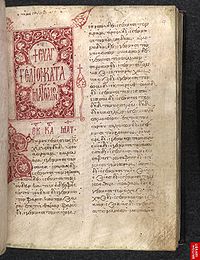Minuscule 715
|
New Testament manuscript |
|

The beginning of Matthew, the decorated headpiece
|
|
| Text | Gospels |
|---|---|
| Date | 13th century |
| Script | Greek |
| Now at | British Library |
| Size | 27 cm by 20.9 cm |
| Type | Byzantine text-type |
| Category | V |
| Note | marginalia |
Minuscule 715 (in the Gregory-Aland numbering), ε364 (von Soden), is a Greek minuscule manuscript of the New Testament, on parchment. Palaeographically it has been assigned to the 13th century. The manuscript has complex contents.Scrivener labelled it as 564e. It has marginalia.
The codex contains the text of the four Gospels, on 176 parchment leaves (size 27 cm by 20.9 cm), and two unfoliated modern paper flyleaves at the beginning and end.
The text is written in two columns per page, 27-29 lines per page. The manuscript has ornamented headpieces, the large initial letters in red, the small initials in red.
The manuscript contains Prolegomena, lists of the κεφαλαια (tables of contents) before each Gospel. The text is divided according to the κεφαλαια (chapters), whose numbers are given at the margin of the text and their τιτλοι (titles of chapters) are given at the top. There is also another division according to the smaller Ammonian Sections (in Mark 237 Sections, the last section in 16:15), which numbers are given at the margin, but without a references to the Eusebian Canons.
It contains lectionary markings at the margin (added by later hand), incipits, Synaxarion, Menologion, subscriptions at the end of each Gospel, numbers of ρηματα, and numbers of στιχοι.
It contains extracts from a commentary of Eulogius of Alexandria and diagnosis of Hesychius (folios 175-176).
The Greek text of the codex is a representative of the Byzantine text-type. Hermann von Soden classified it to Ak, related to the Byzantine commentated text (along with 534, 546, 558, 573).Kurt Aland placed it in Category V.
...
Wikipedia
